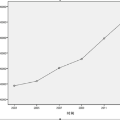For network administration and maintenance, it is critical to anticipate when networks will receive peak volumes of traffic so that adequate resources can be allocated to service requests made to servers. In the event that sufficient resources are not allocated to servers, they can become prone to failure and security breaches. On the contrary, we would waste a lot of resources if we always allocate the maximum amount of resources. Therefore, anticipating peak volumes in network traffic becomes an important problem. However, popular forecasting models such as Autoregressive Integrated Moving Average (ARIMA) forecast time-series data generally, thus lack in predicting peak volumes in these time-series. More than often, a time-series is a combination of different features, which may include but are not limited to 1) Trend, the general movement of the traffic volume, 2) Seasonality, the patterns repeated over some time periods (e.g. daily and monthly), and 3) Noise, the random changes in the data. Considering that the fluctuation of seasonality can be harmful for trend and peak prediction, we propose to extract seasonalities to facilitate the peak volume predictions in the time domain. The experiments on both synthetic and real network traffic data demonstrate the effectiveness of the proposed method.
翻译:对于网络管理和维护来说,预测网络何时会接收到峰值流量非常关键,这样就可以分配足够的资源来服务于服务器接收的请求。如果服务器没有分配足够的资源,那么它们会变得容易出现故障和安全漏洞。因此,预测网络流量中的峰值现象变得非常重要。然而,像自回归移动平均(ARIMA)这样的流行预测模型通常预测时间序列数据,因此在预测这些时间序列中的峰值时缺乏精度。很多时候,时间序列是不同特征的组合,这些特征包括但不限于:1)趋势,流量体积变化的总体趋势;2)季节性,一些时间段内重复出现的模式(例如每天和每月);3)噪声,数据中的随机变化。考虑到季节变化的波动对于趋势和峰值预测可能是有害的,我们提出了提取季节性来便于在时间域内进行峰值流量预测。在合成和真实网络流量数据上的实验验证了该方法的有效性。


